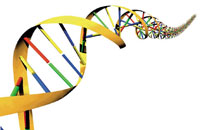Do you really want to live forever?
Source: timesonline.co.uk
There are developments that could (and probably will) lead to humans being able to live forever. But is it desirable?A naturally occurring substance found in the soil of Easter Island, in the southeastern Pacific Ocean, is the latest discovery in Man’s ongoing quest for the elixir of youth. Rapamycin may extend the life expectancy of laboratory mice but, despite the recent hype, there is no evidence that it will do the same for us. It will, however, give researchers a better understanding of why we age — a process that they hope one day to be able to slow or stop. And there is growing optimism that their work is more science fact rather than science fiction.

Ageing is not inevitable. The sea anemone is an example of a species that never appears to age, and there is tremendous variation in life expectancy among animals. Most voles won’t make their first birthday, while a giant tortoise can live to well over 150.
The average life expectancy of a British human being lies almost exactly halfway between these two extremes, with most of us alive today expected to make it well into our eighties — a figure that has risen over the past century as a result of better nutrition, living conditions and healthcare. And this increasing longevity has also been associated with better quality of life. The latest evidence suggests that people who die at 90 spend roughly the same amount of time in hospital as those who die in their seventies, and only twice as long as those who die in their mid-forties.
But to make further inroads into extending our life expectancy we need to do more than negate hazards such as disease and accidents. We need to slow the ticking of our genetic clocks.
At the moment even the best cared for human being is unlikely to make it much beyond 120 because the body’s natural repairing processes grind to a halt and whole systems start to fail.
 Our tissues don’t have a pre-programmed best-before date, but their inbuilt repair processes do, and it is these that largely determine the rate at which we age. Our basic software — DNA — is particularly sensitive to damage, with an attack rate that has been estimated at 10,000 damaging hits per cell, per day. Multiply this figure by the one hundred thousand billion or so cells in the average human body and you get some idea of the challenge faced by our repair systems. Suffice to say there is a bit more to them than healing cuts and grazes.
Our tissues don’t have a pre-programmed best-before date, but their inbuilt repair processes do, and it is these that largely determine the rate at which we age. Our basic software — DNA — is particularly sensitive to damage, with an attack rate that has been estimated at 10,000 damaging hits per cell, per day. Multiply this figure by the one hundred thousand billion or so cells in the average human body and you get some idea of the challenge faced by our repair systems. Suffice to say there is a bit more to them than healing cuts and grazes.The onslaught comes from all directions — everything from sunlight to tobacco smoke — but the main villain is oxygen. We need it to create energy, but in the same way that it turns a newspaper yellow and iron rusty, it also eats away at our structure.
Constant repair uses up a lot of energy and can weaken the processes involved, as demonstrated by what happens when our chromosomes divide during cell replication.
To prevent damage to the DNA during cell renewal, chromosomes contain special structures called telomeres that protect the delicate strands as they unravel and reform. Think of them as the plastic caps on the ends of your shoelaces. The more times the DNA is “tied” and “untied”, the shorter the telomeres become until, perhaps after 100 renewals, the telomeres disappear altogether and the DNA starts to fray. And that is the beginning of the end for the cell.
So, one way to think of our life expectancy is to consider that we are only as old as our telomeres. The longer they are, the longer you are likely to live, and vice versa, as children with the rare condition progeria discover to their cost. A child with progeria is born with unusually short telomeres (roughly the same as those normally found in a 70 or 80-year-old) and ages at an incredible rate, with few living beyond their early teens.
Unfortunately, human adult cells don’t have any way of repairing damaged telomeres, so cell death is inevitable, but a repair enzyme — telomerase — does exist in sperm and the female egg. Researchers in America have managed to insert the genes that produce it into adult skin cells and two years later they were still happily dividing without their telomeres getting any shorter.
Producing a potentially immortal skin cell in a Petri dish in a lab is a long way from significantly extending human life expectancy, but it is a step in the right direction and the solution is likely to come from genetic engineering rather than from some as-yet-undiscovered natural panacea. And it is not so much if, as when.
Any such breakthrough is going to happen too late to help most of us — something that I am actually quite pleased about, as I have no desire to live for ever. I just want to enjoy a full and active life before dropping dead quite unexpectedly some time in my eighties.
Article from: TimesOnline.co.uk
Longevity & The Holy Grail Promo
Aubrey de Grey, Artificial Intelligence, Singularity, Longevity and the Holy Grail
Red Ice Creations Radio - Michael Tsarion - The Post Human World
Sonia Barrett - Immortality and the Quest for Eternal Life
Doctors Baffled, Intrigued by Girl Who Doesn't Age






















